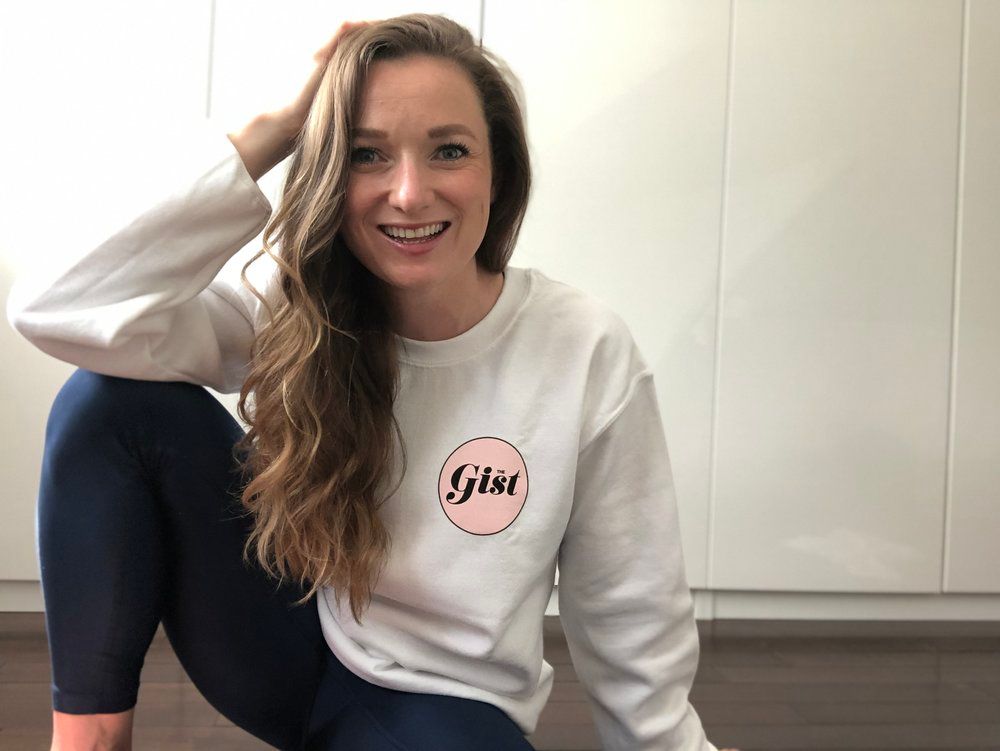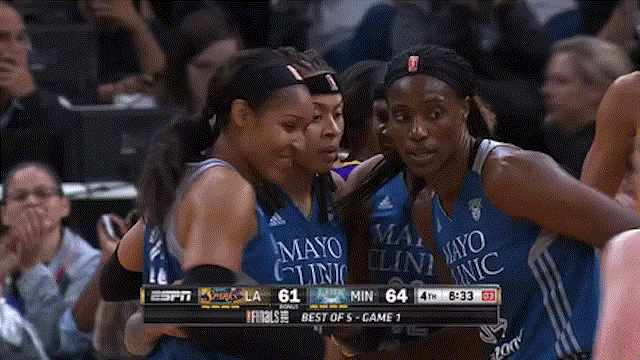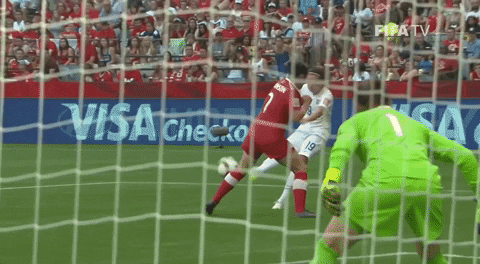Rosie MacLennan

We’re incredibly excited to have Rosie MacLennan on board as a GIST Athlete Ambassador.
Rosie is a two-time Olympic Gold Medalist, two-time World + Pan-Am Games Trampoline champion, and two-times the awesome of the rest of us. But, her advocacy for women in sport and her work with Right To Play really make her the perfect partner to level the playing field with us.
After suffering a broken ankle injury in April, we’re happy to report that Rosie is on track to participate in next summer’s Tokyo 2020 Olympic Games.
After graciously joining us at “Women in Sports who are Leveling the Playing Field” event (co-hosted with Right To Play), she gave us even more of her time to sit down for an interview.
Jacie at The GIST (TG): To kick off this interview, how did you become a trampolinist?
Rosie MacLennan (RM): I grew up the youngest of four kids, and sports were a way that my family interacted and spent our time. My parents introduced us to a ton of different activities and unconventional sports as kids. My older siblings were in gymnastics and they really loved the trampoline portion so they found a trampoline gym. My sister and I tagged along with my older brothers and went to the family class. I’ve been jumping ever since.
c/o of Rosie’s Instagram @rosiemaclennan
TG: What is your favourite memory of your career?
RM: That’s a really hard question to just narrow down to one! I have a lot of awesome memories of training with my teammates... pushing each other, trying new skills and overcoming that fear of accomplishing something for the first time.
But one moment that really stands out is Rio 2016 (Editor’s note: this is where she won her second Olympic gold medal in individual trampoline. NBD). Leading up to Rio, I was coming back from a concussion and facing different obstacles with symptoms, so I wasn’t really sure if I would be back to compete or even qualify.
But the day before the competition, which is the only day we (the gymnasts) get to go in the venue and jump before the competition, all 16 competitors were there, and it worked out that I ended up on a trampoline with only Li Dan from China and we were chatting, smiling, laughing. It really is a tight community and I remember just looking around at these girls I’ve competed against, been inspired by, and worked with through all of these different experiences… and I was just so aware that we were there training under the Olympic rings together. I thought about the last year and all of the things I went through.
It was just a pure moment of gratitude and joy, and it was an incredible feeling that I was able to take that with me into the next day. It was almost like it gave me this armour.
TG: Wow, I love that! I was expecting you to say ‘When I won Gold… or when I won Gold a second time’. That speaks volumes to the community. As fans, we don’t really have that glimpse into the camaraderie and respect amongst rivals.
RM: It’s an interesting dynamic to navigate, but it stems from my coach who is able to put the sport first and coach everyone, and it pushes us all to work and train harder. We (As in Rosie’s coach, training team and her) have athletes come train with us from other places like Japan, Mexico, and the U.S.… and we build these relationships and connections. Like Karen (three-time Olympic medalist Karen Cockburn) is my role model, my teammate, my friend, and my biggest competitor.
Another memory that stands out is with Karen, and how we had always dreamt of standing on the podium together. We didn’t get that opportunity in London. But we did get to share the podium in front of our family and friends and her in front of her daughter at the 2015 Pan Am Games in Toronto. It was an incredible experience… That’s the long answer of my favourite moment of the last 23 years of my life. *Rosie chuckles*
TG: I can only imagine the feeling when you often compete on the road and then finally having a chance to be at home… Anyway, when did you know that being a trampolinist would become your full-time career?
RM: It wasn’t until after high school when I was 18 that I specialized in trampoline. Still, ever since I was a kid I wanted to go to the Olympics before I even really knew what that meant.
Sport was such a big part of my life growing up, but it was always positioned as a hobby. Education was priority #1 and I could only play sports if I got a certain grade. I never saw it as a viable career option until much later and only after watching and interacting with other athletes. That’s one of my biggest goals is to show younger athletes, and especially young girls, that being a professional athlete is a career option.
For Olympic athletes, it is a career and it should be valued the same way you would with another career path. The lessons you learn through sport translate into other careers too, and in so many other aspects of your life.
TG: Now, can you talk about the immense pressure of back-to-back Olympic gold medals and how you--
RM: --Managed that? Haha. Yes. If there was any silver lining to the concussion, that’s where it comes in. There was, or at least from my perspective, a lot of pressure and attention that I probably would have focused on, but because I was in such a challenging situation, it pushed all that stress away. It got to the point where I was thinking, “I don’t give a sh!t, I just want to jump on a trampoline.” I did a lot of work with my sports psychologist and I focused on my progress and acceptance of uncertainty if I didn’t get to where I needed to be. I worked to manage anxiety, stress, and pressure. So when it came time to perform, I felt more prepared for it. I had already processed a lot of the feelings and emotions of uncertainty that comes from qualifying and the Games. It was still going to be emotional, but I had the tools to ground, centre and focus myself.
TG: Had you always worked with a sports psychologist in your career?
RM: It started just after the London 2012 Olympics. I had been having issues with spatial awareness. Retrospectively, that stemmed from a snowboarding fall but nobody knew the connection at the time. I started getting lost in the air which I never had before… it was terrifying. It shattered my confidence and a lot of my strength in psyche, so I started working to manage the fear and anxiety I was facing. I work with him to this day, he’s awesome.
TG: The mental aspect, in individual sports, especially, must be difficult. Is it easy to get in your own head?
RM: It can be. It happened to me last year for a little bit. I was putting so much pressure on myself after taking some time off and then building back. I had no confidence in my program and I wasn’t training my mental piece as much. I was getting so side-tracked by other things and was competing badly, falling, and a lot of it just spiraled. I had to bring it back to “why do I do this sport?” If you can go into a competition knowing you’ve done everything you can to put yourself in the best position to perform and honestly tell yourself that...then no matter what happens on that day, you can go back to training the next because you love it.
TG: I’m so impressed by your positive attitude. I can only imagine what that process and adjustment is like after an injury in the days and weeks after.
RM: It’s definitely a process. My injury (a broken ankle in April) happened in competition. I hit the frame of the trampoline and fell to the ground. Right away I knew it wasn’t good. For some reason I was adamant I had to stand up and present myself to the judges and walk off on my own. I took some time, and eventually I couldn’t walk and had to be carried off. The initial days were just gathering information about the injury and trying not to get ahead of myself. I was trying to be patient which I’m not *lols all around*.
I spent my flight home grieving, losing out on a solid chunk of training after feeling like I was healthier and stronger than I had been in years. When I get back on the trampoline, I’ll have a hill to climb but maybe in some ways I’ll be better because I’ve been able to focus on stability, strength, shoulders or other imbalances I otherwise wouldn’t have worked on. During this injury I’m trying to focus on the technical things I can fix to make me a better trampolinist in the long run. There are still moments of frustration, but I just try to re-frame.
TG: Having a plan in place, and support must help a lot too.
RM: Having the team therapist there right away, and having Karen there as the team director, helped. Karen had fallen in the same manner and hurt her ankle in 2014. She had to get surgery and was still back in four months, so that helped to give me some perspective. And I’m thankful it’s my ankle and not my head.
TG: Very true. Recovery from this ankle injury must be mentally and physically so different from the concussion.
RM: Absolutely. Concussions are still a big mystery, and a huge, intricate puzzle to solve. There’s nothing in medicine that says “okay, do this and you’ll be better”. There’s uncertainty which in itself creates so much anxiety and frustration. It almost felt like there was a blanket over my brain. I knew I was in there, but I wasn’t myself. You experience a lot of physical aspects like headaches, dizziness, insomnia… but there are emotional and psychological aspects that are more complicated to manage. With an ankle, there are challenges, but it’s more concrete. There’s a plan: cast it, crutches, then out of the boot. It’s inevitable that when I get back on the trampoline I won’t have the same range of motion.
TG: With everything that happened in the Larry Nassar scandal, has that translated to your world, and have you seen changes?
RM: Definitely gymnastics in Canada has been affected. There’s more awareness about the issues of power dynamics between athletes and those in more authoritative positions. It’s hard knowing other athletes haven’t had a positive experience when sport can have such a positive influence and impact on our lives. Sport is now swinging in a direction to protect athletes which is critical. Now it’s just figuring out what those policies and structures are, the realities, and where the resources come from. There hasn’t been an increase in resources and funding in years, so it’s a huge complex issue without an easy solution, but it’s about time people are addressing it to protect everyone. Having conversation and hearing the stories and addressing those issues creates an overall environment that’s more open and communicative.
TG: Can you talk about your involvement with Right To Play and why you feel so passionately about it?
RM: Right To Play is an international organization that uses play and sport as a form of education and a way to teach kids different tools and skills to overcome challenges and obstacles they face in day-to-day lives. Right To Play exists in 19 different countries, and Canada actually has some of the biggest programming. It’s easy to buy-in to the organization after reading about what they do and how effective and impactful it is.
When I was in Western Africa for a trip with Right To Play and we shadowed a young girl for a day…and saw her, in part to the Right To Play programming she received, advocating for her right to an education in a community that was only valuing boys’ education. She then created a club within her school advocating for girls’ rights in the school and is now a leader in the community beyond. And that’s just the impact of 1 of 2,000,000 kids.
I learned about Right To Play in high school as an organization that combined things I was very passionate about. At my first international competition in South Africa I was 11 and staying at this beautiful, luxurious resort, but just outside the gates was a slum. At that age I didn’t know how to reconcile that, but it stuck with me and triggered an interest in international development. Then, at Beijing in my first Olympics there was a Right To Play tent in the village and I went there right away to learn about it and get involved. There are so many stories I could share.
Editor’s Note: If you’re interested in learning more about Right to Play or are interested in making a donation, check out RightToPlay.ca.
TG: On another, but somewhat similar note, young girls drop out of sport at double the rate of their male counterparts by the age of 14. How do you think we help combat this?
RM: There’s a lot.
- The education system needs to focus more on physical literacy at a young age so that kids can get comfortable in their body, what it can do, how it can move and how it functions. The more awareness you have on the ability your body has, the more confidence you’ll have in trying new things.
- Kids need to get introduced to broader range of sports. Only so many people can be good at soccer, basketball, volleyball… the conventional sports we typically learn. I was never good at any of those, but trying a bunch of different sports allowed me to find something I connected with. The more you try new things, the better opportunity you’ll have to find something you love.
- Having more role models, including female role models, in various aspects of sport so more girls see it as a viable option. There are a lot of initiatives focusing on this now, but celebrating different bodies and what they can do is important. Focus on what your body can do for you vs. the differences you have from other girls.
TG: What’s one healthy habit you have that an everyday non-elite athlete can insert into their life?
RM: Give yourself at least five minutes every day of quiet and no distractions—no phone, no nothing… just deep breathing. Funny things can happen. You can gain perspective and reconnect with how you’re feeling physically, emotionally and psychologically. Sometimes you have this issue you’ve been thinking about for days and the solution becomes clear when you give yourself some space. I call it “unofficial meditation.”
TG: Unofficial meditation. I like that.
RM: The word “meditation” can be intimidating. I’ve tried meditating, but you get mad at yourself when you start thinking. This gives you space with your thoughts and to accept them. I just try to take time every day to breathe and take space.
TG: Ok, let’s do some rapid-fire questions. Favourite TV show?
RM: Billions right now…of all-time, Friends.
TG: What is your guilty pleasure?
RM: I love chocolate. And coffee...and pizza.
TG: Are you a Harry Potter fan?
RM: I love Harry Potter.
TG: Okay great, us too. Which Harry Potter character would you be?
RM: Hermione is really smart...I also really like Tonks. But anyone who doesn’t know Harry Potter will say who the heck is Tonks.
TG: Oh, no. We love Harry Potter always litter our content with it. Sometimes we think it’s probably too much...
RM: It’s probably not enough.
Don't get The GIST’s free twice-weekly newsletter yet? Let's make it inbox official.

